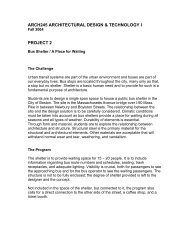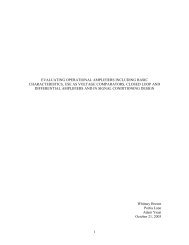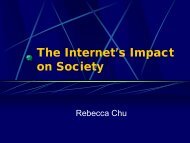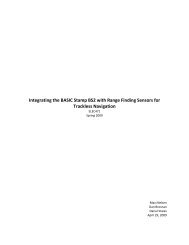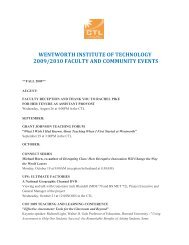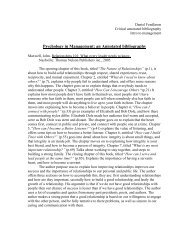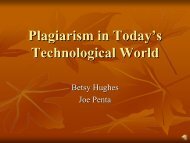International Journal of Art and Aesthetics in ... - DigitalFilm Tree
International Journal of Art and Aesthetics in ... - DigitalFilm Tree
International Journal of Art and Aesthetics in ... - DigitalFilm Tree
You also want an ePaper? Increase the reach of your titles
YUMPU automatically turns print PDFs into web optimized ePapers that Google loves.
POETRY/ORgaNIzINg cREaTIvITY<br />
Borgerson<br />
ThE RElaTIONal aRT Of lEadERShIP<br />
Taylor <strong>and</strong> Karanian<br />
aESThETIc cORPORaTE cOmmuNIcaTION<br />
Gran<br />
ISnn: 1751-9853<br />
ISSN 1751-9853<br />
EmbOdIEd aISThESIS & aESThETIcS IN ORgaNIzINg/<br />
ORgaNIzaTIONS<br />
Küpers<br />
haIkugamI<br />
Kerle<br />
ORgaNIzaTIONal aESThETIcS<br />
Chytry<br />
ShaNghaI cREaTIvE INduSTRIES<br />
Shan<br />
REvIEWS<br />
ThE aRT Of maNagEmENT cONfERENcE ISTaNbul<br />
Volume 2//TwO: 2008<br />
ISSN 1751-9853esthesis<br />
<strong>International</strong> journal <strong>of</strong> art <strong>and</strong> aesthetics <strong>in</strong> management <strong>and</strong> organizational life
aesthesis:<br />
<strong>International</strong> <strong>Journal</strong> <strong>of</strong> <strong>Art</strong> <strong>and</strong> <strong>Aesthetics</strong> <strong>in</strong> Management <strong>and</strong><br />
Organizational Life<br />
is published by<br />
the aesthesis project<br />
The Aesthesis Project was founded <strong>in</strong> January 2007 <strong>and</strong> is a research project <strong>in</strong>vestigat<strong>in</strong>g art <strong>and</strong> aesthetics <strong>in</strong> management <strong>and</strong> organizational<br />
contexts. The project has its roots <strong>in</strong> the first <strong>Art</strong> <strong>of</strong> Management <strong>and</strong> Organization Conference <strong>in</strong> london <strong>in</strong> 2002, with successive conferences held<br />
<strong>in</strong> Paris, Krakow <strong>and</strong> The Banff Centre, Canada. From those events emerged an <strong>in</strong>ternational network <strong>of</strong> academics, writers, artists, consultants <strong>and</strong><br />
managers, all <strong>in</strong>volved <strong>in</strong> explor<strong>in</strong>g <strong>and</strong> experiment<strong>in</strong>g with art <strong>in</strong> the context <strong>of</strong> management <strong>and</strong> organizational research. The Aesthesis Project<br />
will be develop<strong>in</strong>g extensive research <strong>and</strong> artistic projects <strong>in</strong>ternationally, with academic research fellows <strong>and</strong> associate creative practitioners,<br />
publications <strong>and</strong> consultancy.<br />
http://www.essex.ac.uk/aesthesis/<br />
edITOrS<br />
Ian w. K<strong>in</strong>g, essex Management Centre, University <strong>of</strong> essex, Colchester, UK<br />
Jonathan Vickery, Centre for Cultural Policy Studies, University <strong>of</strong> warwick, Coventry, UK<br />
Ceri watk<strong>in</strong>s, essex Management Centre, University <strong>of</strong> essex, Colchester, UK<br />
edITOrIAl COOrdInATOr<br />
Jane Malabar<br />
aesthesis@essex.ac.uk<br />
edITOrIAl AdVISOry BOArd<br />
dawn Ades, University <strong>of</strong> essex, UK<br />
daved Barry, Universidade nova de lisboa, Portugual<br />
Jo Caust, University <strong>of</strong> South Australia, editor, Asia Pacific <strong>Journal</strong> <strong>of</strong> <strong>Art</strong>s <strong>and</strong> Cultural Management<br />
Pierre Guillet de Monthoux, University <strong>of</strong> Stockholm, Sweden<br />
laurie Heizler, wright Hassall llP, leam<strong>in</strong>gton Spa, UK<br />
Stephen l<strong>in</strong>stead, University <strong>of</strong> york, UK<br />
nick nissley, The Banff Centre, Canada<br />
Antonio Strati, University <strong>of</strong> Trento <strong>and</strong> University <strong>of</strong> Siena, Italy<br />
Steve Taylor, worcester Polytechnic Institute, USA<br />
deSIGn & ArT dIreCTIOn<br />
Jonathan Vickery<br />
dIGITAl ArTwOrK<br />
Integra Communications, Oxford, UK<br />
The views <strong>and</strong> assertions articulated <strong>in</strong> this publication do not necessarily represent the views or<br />
judgements <strong>of</strong> the editors or <strong>of</strong> The Aesthesis Project.<br />
ISSn 1751-9853<br />
Aesthesis © 2008: The Aesthesis Project
editorial // 2<br />
poetry lessons: On Organiz<strong>in</strong>g creativity<br />
Janet L. Borgerson // 4<br />
WOrk<strong>in</strong>g cOnnectiOn: the relatiOnal art Of leadership<br />
steven s. taylor <strong>and</strong> Barbara A. Karanian // 15<br />
lOOk WhO’s talk<strong>in</strong>g!<br />
- aesthetic cOrpOrate cOmmunicatiOn <strong>in</strong> a dedifferentiated<br />
sOciety<br />
Anne-Britt Gran // 23<br />
the sense-mak<strong>in</strong>g Of the senses: mark<strong>in</strong>g the sensual<br />
as mak<strong>in</strong>g sense – perspectives On embOdied aisthesis &<br />
aesthetics <strong>in</strong> Organiz<strong>in</strong>g/OrganizatiOns<br />
Wendel<strong>in</strong> M. Küpers // 33<br />
haikugami<br />
Ralph Kerle // 54<br />
OrganizatiOnal aesthetics: the artful firm <strong>and</strong> the aesthetic<br />
mOment <strong>in</strong> OrganizatiOn <strong>and</strong> management theOry<br />
Josef chytry // 60<br />
shanghai creative <strong>in</strong>dustries: the emergence Of the creative<br />
class <strong>in</strong> ch<strong>in</strong>a?<br />
L<strong>in</strong>l<strong>in</strong> shan // 73<br />
revieWs<br />
Andrew Rowe // 85 erica Pastore // 86<br />
the art Of management <strong>and</strong> OrganizatiOn<br />
cOnference istanbul // 88<br />
contents<br />
contents
Work<strong>in</strong>g connection:<br />
the Relational <strong>Art</strong> <strong>of</strong> Leadership<br />
draw<strong>in</strong>g upon ideas <strong>of</strong> relational leadership,<br />
leadership as an art, <strong>and</strong> organizational aesthetics,<br />
we conceptualize relational leadership as an art<br />
that works with connection as its medium. We<br />
illustrate the practice <strong>of</strong> work<strong>in</strong>g connection<br />
with an example <strong>of</strong> an entrepreneurial leader,<br />
which shows how he, sometimes dist<strong>in</strong>ctly <strong>and</strong><br />
sometimes ambiguously, works with connection.<br />
We then discuss the implications <strong>of</strong> approach<strong>in</strong>g<br />
leadership as an art that is enacted through<br />
work<strong>in</strong>g connection.<br />
If we are to take seriously the idea that<br />
leadership is an art (Barnard 1938; DePree<br />
1989), then we might ask – is it a visual art,<br />
is it an all encompass<strong>in</strong>g sensory art, is it a<br />
literary art, is it an aural art? Which is also<br />
to ask, what is the medium <strong>of</strong> the art <strong>of</strong><br />
leadership? At first blush, leadership uses<br />
the human body as a medium, much <strong>in</strong> the<br />
way that theater, dance, <strong>and</strong> storytell<strong>in</strong>g do.<br />
that is to say, as has been said before, that<br />
leadership is a perform<strong>in</strong>g art (e.g. Gr<strong>in</strong>t 2001;<br />
Vaill 1989).<br />
But to identify the human body as the<br />
medium <strong>of</strong> leadership is to take an<br />
<strong>in</strong>dividualist perspective on leadership, to<br />
place leadership as someth<strong>in</strong>g that is done<br />
by <strong>and</strong> to <strong>in</strong>dividual humans. We start with<br />
the assumption that leadership is a relational<br />
phenomena – it occurs not with<strong>in</strong> <strong>in</strong>dividuals,<br />
but between <strong>in</strong>dividuals (cf. Uhl-Bien 2006).<br />
Work<strong>in</strong>g from that position, leadership does<br />
not use the human body as a medium, it uses<br />
the space between people as its medium.<br />
Leadership is an art that works <strong>in</strong> the<br />
connection between humans.<br />
Part <strong>of</strong> any art is the mastery, technique, or<br />
skill <strong>of</strong> work<strong>in</strong>g the medium. Whether it is<br />
steven s. taylor<br />
Barbara A. Karanian<br />
a pa<strong>in</strong>ter’s skill with brush, pa<strong>in</strong>t, <strong>and</strong> canvas, an actor’s skill with voice, body <strong>and</strong><br />
creat<strong>in</strong>g emotional reality (e.g. Hagen 1973; stanislavski 1936), or a drummer’s<br />
ability to play complex rhythms on their drum set, the craft is an important part <strong>of</strong><br />
their art. Drummers spend years learn<strong>in</strong>g how to play the drums <strong>and</strong> perfect<strong>in</strong>g their<br />
expertise. When a group <strong>of</strong> jazz drummers gather, very rapidly the discussion turns<br />
to types <strong>and</strong> br<strong>and</strong>s <strong>of</strong> cymbals (Hatch et al. 2004). similarly, pa<strong>in</strong>ters are prone to<br />
talk about brushes, palette knives <strong>and</strong> mix<strong>in</strong>g diverse mediums together to pa<strong>in</strong>t.<br />
this is because it is <strong>in</strong> the method through the medium <strong>of</strong> the art form that the<br />
art is enacted – it is <strong>in</strong> the details <strong>of</strong> work<strong>in</strong>g the medium that the rubber meets<br />
the road. the drummers’ <strong>in</strong>ner artistic sensibilities may lead them to want a livelier<br />
cymbal sound <strong>in</strong> a particular song, but that livelier symbol sound will be realized <strong>in</strong><br />
the use <strong>of</strong> a specific br<strong>and</strong> <strong>and</strong> type <strong>of</strong> cymbal, struck with a particular drumstick or<br />
brush, with a specific technique.<br />
thus if we are to take seriously the idea that leadership is an art, we need to<br />
consider the medium <strong>of</strong> that art <strong>and</strong> how it is worked because that is where the art<br />
<strong>of</strong> leadership is enacted. one leader who works the connection between humans<br />
is a filmmaker — named Ramy — who says, “We never read the manual that said<br />
to separate the creative people from the technical people. In fact, our <strong>in</strong>dustry<br />
doesn’t get it. they don’t believe us or know what we do. they th<strong>in</strong>k it’s impossible<br />
to artistically collaborate the way we do”, as he participated <strong>in</strong> a design methods<br />
sem<strong>in</strong>ar with graduate students. In order to lay the ground for look<strong>in</strong>g at how<br />
Ramy works connection we start with a discussion <strong>of</strong> what we mean by relational<br />
leadership, why leadership should be considered an art, <strong>and</strong> the relationship<br />
between organizational aesthetics <strong>and</strong> connection, all <strong>of</strong> which br<strong>in</strong>gs us to a<br />
fuller <strong>and</strong> more nuanced conceptual underst<strong>and</strong><strong>in</strong>g <strong>of</strong> what we mean by the art <strong>of</strong><br />
relational leadership. We then turn to Ramy <strong>in</strong> more detail to illustrate the practice<br />
<strong>of</strong> how relational leaders work connection, clos<strong>in</strong>g with what this tells about the<br />
idea <strong>of</strong> leadership as art.<br />
AestHesIs Vol. 2 // tWo: 2008 // 2
tHe ARt oF ReLAtIonAL LeADeRsHIP<br />
In order to develop a more nuanced conception <strong>of</strong> the art <strong>of</strong> relational leadership, we<br />
will break down the phrase, discuss<strong>in</strong>g the parts <strong>of</strong> it <strong>in</strong> turn. We beg<strong>in</strong> with the idea<br />
<strong>of</strong> relational leadership, draw<strong>in</strong>g upon Mary Uhl-Bien’s (2006) approach. she breaks<br />
down relational leadership <strong>in</strong>to two theoretical approaches, an entity perspective <strong>and</strong><br />
a relational perspective. Although both are concerned with leadership as a phenomenon<br />
that <strong>in</strong>volves both leaders <strong>and</strong> followers, the entity perspective exam<strong>in</strong>es the<br />
relationship from the perspective <strong>of</strong> the <strong>in</strong>dividuals (the leader <strong>and</strong> followers). she<br />
identifies the entity perspective as be<strong>in</strong>g based <strong>in</strong> an ontology <strong>of</strong> objective truth <strong>and</strong><br />
be<strong>in</strong>g concerned with how the <strong>in</strong>dividual perceives <strong>and</strong> <strong>in</strong>fluences the relationship<br />
with the other. In contrast, the relational perspective is based <strong>in</strong> an ontology <strong>of</strong> social<br />
construction <strong>and</strong> is concerned with the relationship itself, which it sees as be<strong>in</strong>g constantly<br />
constructed <strong>in</strong> processes.<br />
We conceptualize relational leadership from Uhl-Bien’s relational perspective. one key<br />
consequence <strong>of</strong> the relational approach is that it moves the focus from underst<strong>and</strong><strong>in</strong>g<br />
leadership effectiveness to underst<strong>and</strong><strong>in</strong>g the relational processes by which leadership<br />
is produced, which fits with our concern with the craft <strong>of</strong> the art <strong>of</strong> leadership. In<br />
artistic terms, we are not so much concerned with a judgment <strong>of</strong> the quality <strong>of</strong> the<br />
f<strong>in</strong>ished pa<strong>in</strong>t<strong>in</strong>g, but rather what techniques <strong>and</strong> methods have been used to produce<br />
the pa<strong>in</strong>t<strong>in</strong>g <strong>and</strong> how those methods affect the f<strong>in</strong>ished pa<strong>in</strong>t<strong>in</strong>g.<br />
the idea that leadership is an art is certa<strong>in</strong>ly not new. Barnard told us, ‘It is a matter <strong>of</strong><br />
art rather than science, <strong>and</strong> is aesthetic rather than logical’ (1938: 235). Just look<strong>in</strong>g<br />
at our own bookshelf <strong>of</strong>fers titles such as the <strong>Art</strong> <strong>of</strong> leadership (Bothwell 1983), the<br />
<strong>Art</strong> <strong>and</strong> science <strong>of</strong> leadership (nahav<strong>and</strong>i 1997), the <strong>Art</strong> <strong>of</strong> the leader (cohen, 1990),<br />
the <strong>Art</strong>s <strong>of</strong> leadership (Gr<strong>in</strong>t 2001), <strong>and</strong> the three Faces <strong>of</strong> leadership: <strong>Art</strong>ist, Manager,<br />
priest (Hatch et al. 2004). there has been a gradual movement from us<strong>in</strong>g the<br />
idea <strong>of</strong> leadership as an art rather loosely, to more <strong>and</strong> more detailed use <strong>of</strong> specific<br />
aesthetic philosophy. As an example, Duke (1986) simply argued for four aesthetic<br />
properties <strong>of</strong> leadership. twenty years later, Ladk<strong>in</strong> (2006) is ga<strong>in</strong><strong>in</strong>g new <strong>in</strong>sights <strong>in</strong>to<br />
charismatic leadership by view<strong>in</strong>g it through Kant’s idea <strong>of</strong> the sublime, <strong>and</strong> samier<br />
<strong>and</strong> Bates (2006) are present<strong>in</strong>g a variety <strong>of</strong> specific philosophic stances on leadership<br />
<strong>and</strong> adm<strong>in</strong>istration. Although this movement has <strong>of</strong>fered deeper <strong>in</strong>sights <strong>in</strong>to<br />
leadership, it is important to recognize that it comes from a position <strong>of</strong> art criticism<br />
rather than art practice (taylor <strong>and</strong> carbone 2008). that is to say, it is based <strong>in</strong> an <strong>in</strong>tellectual<br />
approach to art that tends to be taken by academics <strong>and</strong> critics rather than<br />
an embodied approach that is taken by teachers <strong>and</strong> artists. the <strong>in</strong>tellectual approach<br />
is look<strong>in</strong>g for clear analytic <strong>in</strong>sight <strong>and</strong> conceptualization, while the practice approach<br />
is look<strong>in</strong>g for examples <strong>of</strong> embodied know<strong>in</strong>g which are particular to the situation, but<br />
<strong>in</strong> that particularity may <strong>of</strong>fer some useful <strong>in</strong>sight. As many creative writ<strong>in</strong>g teachers<br />
will say, the more specific <strong>and</strong> concrete the detail, the more it generalizes for the<br />
reader. As we speak <strong>of</strong> relational leadership as work<strong>in</strong>g connection, we are speak<strong>in</strong>g<br />
from an art practice perspective <strong>and</strong> our hope is to <strong>of</strong>fer specific practices rather than<br />
an analytic conceptualization <strong>of</strong> the art <strong>of</strong> relational leadership.<br />
When leadership is spoken <strong>of</strong> as an art, this is somehow different from an art<br />
such as pa<strong>in</strong>t<strong>in</strong>g, sculpture, or dance. the difference is that while every art is<br />
formative, that is the art is about form<strong>in</strong>g someth<strong>in</strong>g – the art <strong>of</strong> negotiation<br />
is about form<strong>in</strong>g an agreement <strong>in</strong> the face <strong>of</strong> conflict<strong>in</strong>g <strong>in</strong>terests, the art <strong>of</strong><br />
sculpture is about form<strong>in</strong>g sculpture out <strong>of</strong> marble or some other material<br />
– the ‘pure’ arts are about formativeness for the sake <strong>of</strong> form<strong>in</strong>g, while the<br />
applied arts have an <strong>in</strong>strumental purpose (strati 1999). so what does this<br />
mean when applied to managerial action such as leadership?<br />
Goodsell suggests that management is ‘an art <strong>in</strong> the ancient sense <strong>of</strong> that word, i.e.<br />
it embodies a specialized skill that is capable <strong>of</strong> creat<strong>in</strong>g results that are both usable<br />
<strong>and</strong> pleas<strong>in</strong>g to behold. specific objects are created <strong>and</strong> tasks performed, yet <strong>in</strong> ways<br />
<strong>and</strong> with consequences that establish <strong>in</strong> the m<strong>in</strong>ds <strong>of</strong> both creator <strong>and</strong> audience a<br />
sense <strong>of</strong> <strong>in</strong>tr<strong>in</strong>sic satisfaction, above <strong>and</strong> beyond the utilitarian purpose at h<strong>and</strong>’,<br />
but not necessarily unrelated to it (Goodsell 1992: 247). Kuhn says, ‘the process<br />
<strong>of</strong> ‘manag<strong>in</strong>g’ becomes art as those<br />
<strong>in</strong>volved create mean<strong>in</strong>g, construct form,<br />
recognize patterns, <strong>and</strong> place values on<br />
relationships with others. It is an art that<br />
exists only <strong>in</strong> process’ (Kuhn 1996: 223).<br />
We suggest that the primary medium<br />
that leaders form <strong>and</strong> work with <strong>in</strong> order<br />
to accomplish the <strong>in</strong>strumental goals<br />
<strong>of</strong> the organization is the connections<br />
between people.<br />
Although we have all seen or at least can<br />
imag<strong>in</strong>e how a pa<strong>in</strong>ter works with<strong>in</strong> one<br />
medium with their pa<strong>in</strong>ts, brushes, <strong>and</strong><br />
canvas to create a pa<strong>in</strong>t<strong>in</strong>g, what it actually<br />
means to work connection is less<br />
clear. We cannot see, touch, taste, smell,<br />
or hear connection. But we can feel connection.<br />
What does it mean to feel connected<br />
to each other? to feel someth<strong>in</strong>g<br />
implies a way <strong>of</strong> know<strong>in</strong>g that is <strong>in</strong>tuitive<br />
<strong>and</strong> holistic (Beardsley 1982), a way <strong>of</strong><br />
know<strong>in</strong>g that is unmediated by deductive<br />
or <strong>in</strong>ductive reason<strong>in</strong>g (csikszentmihalyi<br />
<strong>and</strong> Rob<strong>in</strong>son 1990), a way <strong>of</strong> know<strong>in</strong>g<br />
the ‘felt mean<strong>in</strong>g’ (courtney 1995) <strong>of</strong> an<br />
experience; all <strong>of</strong> which are also descriptions<br />
<strong>of</strong> aesthetic experience.<br />
the most common conception <strong>of</strong> aesthetics<br />
with<strong>in</strong> organizational aesthetics<br />
is as the study <strong>of</strong> sensible know<strong>in</strong>g<br />
that is apprehended directly by the five<br />
senses. As Ramirez puts it:<br />
‘<strong>Aesthetics</strong> is that branch <strong>of</strong> Western<br />
philosophy that deals with the forms <strong>of</strong><br />
underst<strong>and</strong><strong>in</strong>g, perception, conception,<br />
<strong>and</strong> experience which we qualify (<strong>of</strong>ten<br />
after the fact) with adjectives such as<br />
‘beautiful’, ‘ugly’, ‘elegant’, or ‘repulsive’.<br />
Aesthetic knowledge depends largely<br />
on sens<strong>in</strong>g <strong>and</strong> feel<strong>in</strong>g, on empathy <strong>and</strong><br />
<strong>in</strong>tuition, <strong>and</strong> on relat<strong>in</strong>g conception to<br />
perception’. (Ramirez 2005: 29)<br />
However, there is another way <strong>of</strong> th<strong>in</strong>k<strong>in</strong>g<br />
about aesthetics that explicitly l<strong>in</strong>ks<br />
connection <strong>and</strong> aesthetics. this conceptualization<br />
<strong>of</strong> aesthetic experience<br />
comes from Ramirez’s (1991) concept<br />
<strong>of</strong> the beauty <strong>of</strong> social organization.<br />
Ramirez starts by develop<strong>in</strong>g a systems<br />
theory <strong>of</strong> organizational beauty. Be<strong>in</strong>g ‘a<br />
part <strong>of</strong>’ a system simultaneously means<br />
‘belong<strong>in</strong>g to’ <strong>and</strong> ‘dist<strong>in</strong>ct from’. the<br />
aesthetic experience <strong>of</strong> beauty comes<br />
from the feel<strong>in</strong>g <strong>of</strong> ‘belong<strong>in</strong>g to’. or<br />
as Bateson said, ‘By aesthetic, I mean<br />
responsive to the pattern that connects’<br />
m<strong>in</strong>d <strong>and</strong> nature (quoted <strong>in</strong> Ramirez,<br />
1991: 38). s<strong>and</strong>el<strong>and</strong>s (1998) expresses<br />
// 3 AestHesIs Vol. 2 // tWo: 2008
this idea slightly differently. He suggests<br />
that people have a dual nature as an <strong>in</strong>dividual<br />
<strong>and</strong> as a member <strong>of</strong> a social group,<br />
much <strong>in</strong> the way that Ramirez speaks<br />
<strong>of</strong> the ‘separate from’ (<strong>in</strong>dividual) <strong>and</strong><br />
‘belong<strong>in</strong>g to’ (part <strong>of</strong> a group) aspects<br />
<strong>of</strong> a system. s<strong>and</strong>el<strong>and</strong>s goes on to<br />
argue that feel<strong>in</strong>gs <strong>of</strong> be<strong>in</strong>g part <strong>of</strong> the<br />
group are expressed <strong>and</strong> made object<br />
through art. thus where Bateson said<br />
that aesthetic experience was responsive<br />
to connection, s<strong>and</strong>el<strong>and</strong>s argues<br />
connection is the basis <strong>of</strong> aesthetic<br />
experience. clair (1998) echoes Bateson’s<br />
underst<strong>and</strong><strong>in</strong>g <strong>of</strong> connection be<strong>in</strong>g<br />
central to aesthetics, trac<strong>in</strong>g it back to<br />
a variety <strong>of</strong> <strong>in</strong>digenous cultures’ concept<br />
<strong>of</strong> aesthetics. In particular, she discusses<br />
traditional cherokee aesthetics as be<strong>in</strong>g<br />
from a circular (rather than l<strong>in</strong>ear) culture<br />
where connection is crucial <strong>and</strong> aesthetics<br />
permeates all aspects <strong>of</strong> life.<br />
Although there is a common theme<br />
that aesthetics is somehow related to<br />
connection between people, there is no<br />
clear, agreed upon, theoretical underst<strong>and</strong><strong>in</strong>g<br />
<strong>of</strong> what exactly the relationship<br />
between connection <strong>and</strong> aesthetics is.<br />
Follow<strong>in</strong>g <strong>in</strong> that ve<strong>in</strong>, we suggest that<br />
rather than connection be<strong>in</strong>g the basis<br />
<strong>of</strong> aesthetic experience (Ramirez 1991),<br />
or that aesthetic forms are the expression<br />
<strong>of</strong> connection (s<strong>and</strong>el<strong>and</strong>s 1998),<br />
<strong>in</strong>stead connection is the medium <strong>of</strong> the<br />
art <strong>of</strong> relational leadership. By tak<strong>in</strong>g<br />
this conceptualization <strong>of</strong> the relationship<br />
between aesthetics <strong>and</strong> connection, we<br />
can conceptualize the practice <strong>of</strong> leaders<br />
<strong>and</strong> consider the craft <strong>of</strong> relational<br />
leadership, which we will do <strong>in</strong> the next<br />
section.<br />
But first, let us illustrate what we mean<br />
by craft or technique with an example<br />
from the technique <strong>of</strong> pa<strong>in</strong>t<strong>in</strong>g with watercolors.<br />
In one technique, heavy weight<br />
paper is drenched <strong>in</strong> water <strong>and</strong> used as a<br />
foundation for wet pa<strong>in</strong>t that is applied<br />
for a not completely predictable outcome.<br />
creat<strong>in</strong>g beg<strong>in</strong>s <strong>in</strong> the saturation<br />
<strong>of</strong> color applied to a surface appear<strong>in</strong>g<br />
to move with the motion <strong>of</strong> water <strong>and</strong><br />
ends <strong>in</strong> the surprise <strong>of</strong> a still outcome. A<br />
deep cadmium red blended with yellow<br />
ochre <strong>and</strong> a touch <strong>of</strong> rich, raw umber<br />
dries on the surface to provide shadow<br />
<strong>and</strong> depth perspective to urban build<strong>in</strong>gs<br />
such as those pictured <strong>in</strong> figure 1. Ultra<br />
mar<strong>in</strong>e blue <strong>and</strong> alizar<strong>in</strong> crimson mix to<br />
create the illusion <strong>of</strong> lavender <strong>in</strong> a foggy<br />
expansive sky. the use <strong>of</strong> <strong>in</strong>k <strong>and</strong> bronze<br />
AestHesIs Vol. 2 // tWo: 2008<br />
powder are saturation modifications. More than a concept or <strong>in</strong>tellectual theory <strong>of</strong><br />
pa<strong>in</strong>t<strong>in</strong>g is be<strong>in</strong>g applied, but rather an embodied practice. We now turn to the embodied<br />
techniques <strong>of</strong> the art <strong>of</strong> relational leadership, as we see them <strong>in</strong> the practice <strong>of</strong><br />
Ramy, the filmmaker.<br />
WoRKInG connectIon<br />
When we speak <strong>of</strong> work<strong>in</strong>g connection, we are talk<strong>in</strong>g about the art <strong>and</strong> construction,<br />
the skills, <strong>and</strong> the techniques <strong>of</strong> relational leadership. It is similar to talk<strong>in</strong>g about how<br />
a watercolor pa<strong>in</strong>ter may work with wet pa<strong>in</strong>t on a wet surface. It is similar to a trombone<br />
player talk<strong>in</strong>g about the technique <strong>of</strong> double tongu<strong>in</strong>g. It is like a storyteller’s art<br />
<strong>of</strong> mak<strong>in</strong>g contact with the audience just long enough to communicate a thought to<br />
them (snyder 1990).<br />
We draw upon the story <strong>of</strong> our filmmaker Ramy, that was created as part <strong>of</strong> a larger<br />
study <strong>of</strong> successful, entrepreneurial leaders (Karanian 2007) to illustrate ways that<br />
an artistic-relational-leader can work connection. We say illustrate <strong>in</strong> the sense that<br />
an image illustrates a story, not <strong>in</strong> the sense that an example illustrates a theory. We<br />
do not <strong>in</strong>tend to suggest that the ways Ramy works connection are the only ways<br />
that connection is worked by relational artistic leaders, but rather that they are<br />
specific techniques that Ramy uses <strong>and</strong> that by look<strong>in</strong>g at them <strong>in</strong> more detail we<br />
may get someth<strong>in</strong>g <strong>of</strong> a feel <strong>of</strong> what it means to work connection. Much <strong>of</strong> the way <strong>in</strong><br />
which he works connection is by creat<strong>in</strong>g the conditions for connections to flourish,<br />
although he does also directly work the relationships. these come together as he<br />
appreciates the moments <strong>of</strong> connection <strong>in</strong> relationship to the diverse group, <strong>and</strong> tells<br />
his truth.<br />
We start with the physical conditions <strong>of</strong> his first studio/<strong>of</strong>fice. Images emerge immediately<br />
after the first few m<strong>in</strong>utes <strong>of</strong> walk<strong>in</strong>g <strong>in</strong> to the multi-level stucco West<br />
Hollywood home converted <strong>in</strong>to his futuristic oasis <strong>of</strong> video, film, <strong>and</strong> documentary<br />
mak<strong>in</strong>g. there is a maze <strong>of</strong> cubby-holes <strong>and</strong> paths <strong>and</strong> stairways to everyone work<strong>in</strong>g<br />
— <strong>in</strong>dividually <strong>and</strong> connected together — by concrete <strong>and</strong> symbolic evidence <strong>of</strong> ongo<strong>in</strong>g<br />
success. Presents sent <strong>in</strong> the form <strong>of</strong> coconuts, tequila, <strong>and</strong> monkeys <strong>in</strong>dicate<br />
a playful <strong>and</strong> exhilarat<strong>in</strong>g promise for fun while people work hard. orig<strong>in</strong>al thoughts,<br />
clear, unwaver<strong>in</strong>g magnetic focus, an agile almost boundless bounce from one place<br />
to another are first impressions <strong>of</strong> Ramy. the l<strong>and</strong> <strong>of</strong> Ramy, founder <strong>and</strong> c.e.o. along<br />
with his very talented group at Hollywood Digital, teems with the k<strong>in</strong>d <strong>of</strong> energy that<br />
would motivate every entrepreneurial th<strong>in</strong>ker to wake up early <strong>and</strong> run to work. Ramy<br />
expla<strong>in</strong>s this with the general description that it is important that everyone be comfortable,<br />
but we see that there is more at work here than simply be<strong>in</strong>g comfortable.<br />
He has created a space where he both physically <strong>and</strong> psychologically creates opportunities<br />
for connection. the importance <strong>of</strong> this space is shown <strong>in</strong> the follow<strong>in</strong>g story:<br />
“comfort matters,” he suggests. there is a paradox <strong>of</strong> comfort <strong>in</strong> teams that don’t<br />
apparently belong together. Yet, Ramy has created ways at Hollywood Digital for connect<strong>in</strong>g,<br />
collaborative, multi-branch<strong>in</strong>g teams that produce films for large unknown<br />
audiences. “People are comfortable here <strong>and</strong> stay <strong>and</strong> do all this work. If they are not<br />
comfortable, they know it <strong>and</strong> they just leave. no one has to ask them to leave.”<br />
“one example <strong>of</strong> discomfort occurred when my lead<strong>in</strong>g digital artist disappeared”.<br />
Ramy expla<strong>in</strong>s. “He didn’t say anyth<strong>in</strong>g, he just left for days. He disappeared. I gave<br />
him some space, not worry<strong>in</strong>g yet that he wouldn’t follow-through, but f<strong>in</strong>ally talked<br />
to him about his concerns. And, <strong>of</strong> course, the concerns weren’t technical. the digital<br />
effects artist was concerned that, with the move to the larger space, he would be<br />
lost <strong>in</strong> the big, impersonal mach<strong>in</strong>e <strong>of</strong> the huge movie house. He worried that he<br />
would no longer be motivated to be on the team, <strong>and</strong> that we would no longer be a<br />
team. so, I am work<strong>in</strong>g on that transition for everyone from our smaller space to the<br />
larger one. I am work<strong>in</strong>g on it. It’s a day to day, real time th<strong>in</strong>g”.<br />
the digital artist feels the importance <strong>of</strong> the physical <strong>and</strong> psychological space that<br />
Ramy has created. the digital effects artist’s sense <strong>of</strong> team is the connection that<br />
has been created <strong>in</strong> the space that Ramy has worked. to keep that connection, Ramy<br />
knows he must pay close attention, participate <strong>and</strong> help facilitate the artist’s adjustment<br />
to the new space.<br />
// 4
5
Ramy also works the conditions for connection as he selects diverse people to work<br />
together on his projects. Unexpected twists turn up everywhere. People, who under<br />
normal circumstances wouldn’t be work<strong>in</strong>g together, design, construct, <strong>and</strong> modify<br />
everyth<strong>in</strong>g <strong>in</strong> the production cycle <strong>of</strong> film mak<strong>in</strong>g. “I pick the best”, directs Ramy. the<br />
significance <strong>of</strong> this statement is illustrated by a company culture founded on the pr<strong>in</strong>ciple<br />
that people from backgrounds that are diverse, based on education, tra<strong>in</strong><strong>in</strong>g, <strong>and</strong><br />
past experience will collaborate exquisitely when <strong>in</strong>novation is the goal.<br />
the culture created by Ramy is rem<strong>in</strong>iscent <strong>of</strong> one found <strong>in</strong> many high-achiev<strong>in</strong>g, but<br />
never arrogant academic <strong>in</strong>stitutions. Gett<strong>in</strong>g the absolutely best <strong>in</strong>dividual for the<br />
work is the key. creativity <strong>and</strong> best practices are so highly valued <strong>in</strong> the company that<br />
Ramy searches for <strong>and</strong> chooses the top performer with a goal toward seamless communication.<br />
And when Hollywood Digital enters the color phase <strong>of</strong> the project <strong>and</strong> the<br />
f<strong>in</strong>al attention to details <strong>of</strong> the story l<strong>in</strong>e, visual effects, saturation, etc. there is almost<br />
no f<strong>in</strong>ish<strong>in</strong>g l<strong>in</strong>e on completion.<br />
But it is not simply a case <strong>of</strong> select<strong>in</strong>g the best people <strong>and</strong> putt<strong>in</strong>g them together.<br />
Ramy is work<strong>in</strong>g connection <strong>in</strong> a more sophisticated way than that as he selects people<br />
to work on the pre <strong>and</strong> post production process for his films. He works the conditions<br />
for connection, organiz<strong>in</strong>g <strong>and</strong> creat<strong>in</strong>g cross-functional teams with the expectation<br />
that someth<strong>in</strong>g wonderful will happen. A six-month Hollywood writer’s strike provides<br />
an example. corrosive to any productive team vibe, many <strong>in</strong> the television <strong>and</strong> movie<br />
<strong>in</strong>dustry used the strike as an opportunity for extreme cost-cutt<strong>in</strong>g lay-<strong>of</strong>fs. not Ramy.<br />
He pulled his team together <strong>and</strong> reiterated that it was because they all began together<br />
as a team that they would move forward together — even dur<strong>in</strong>g this difficult stage<br />
— as a team. then they used the strike conditions to <strong>of</strong>fer someth<strong>in</strong>g new, <strong>and</strong> the<br />
company thrived <strong>and</strong> completed award w<strong>in</strong>n<strong>in</strong>g work.<br />
An example <strong>of</strong> how he works the conditions for connection to foster the creation <strong>of</strong> <strong>in</strong>terest<strong>in</strong>g<br />
<strong>and</strong> important connections, consider how Ramy pa<strong>in</strong>ts a picture <strong>of</strong> leadership<br />
that is brimm<strong>in</strong>g with awareness <strong>of</strong> participant <strong>and</strong> viewer. His goal is to work with female<br />
camera operators. “You rarely if ever see ‘girls’ beh<strong>in</strong>d the camera. But I remember<br />
be<strong>in</strong>g fasc<strong>in</strong>ated as I watched a woman film<strong>in</strong>g on Hollywood Boulevard. th<strong>in</strong>k about<br />
it,” he said. “What happens when there is a guy beh<strong>in</strong>d the camera. What are people’s<br />
perceptions? th<strong>in</strong>k about it. that doesn’t happen if it’s a girl. I have a goal here — to<br />
get women as photographers.” Ramy cont<strong>in</strong>ued to discuss the ease <strong>and</strong> comfort <strong>of</strong><br />
that particular solo woman photographer <strong>and</strong> how she connected persuasively as she<br />
carried her equipment <strong>and</strong> received responses naturally from passers-by.<br />
Here he has seen the possibility for creat<strong>in</strong>g new <strong>and</strong> different connections between<br />
the public <strong>and</strong> the film crew that may translate <strong>in</strong>to someth<strong>in</strong>g new <strong>and</strong> different <strong>in</strong><br />
the f<strong>in</strong>al product, simply by chang<strong>in</strong>g the gender <strong>of</strong> his camera person. He wonders<br />
about how the way it feels to be filmed by a woman or a man will create conditions for<br />
a natural response. He doesn’t know exactly what, if anyth<strong>in</strong>g will happen differently<br />
with a female beh<strong>in</strong>d the camera rather than a man, but he does sense the gendered<br />
aspect <strong>of</strong> the role <strong>and</strong> creates the possibility for new connections. Gender presents another<br />
variable for susta<strong>in</strong><strong>in</strong>g success <strong>in</strong> this male-dom<strong>in</strong>ated team. enthusiastic about<br />
the value <strong>of</strong> other than male actions on a team, Ramy is exuberant about search<strong>in</strong>g<br />
for females to jo<strong>in</strong> his team. “Where are all the women <strong>and</strong> why won’t they stay <strong>in</strong> our<br />
<strong>in</strong>dustry?” are comments <strong>in</strong>dicat<strong>in</strong>g his concerns <strong>and</strong> worry that he needs to f<strong>in</strong>d ways<br />
to do more.<br />
Ramy’s work<strong>in</strong>g <strong>of</strong> connection is also manifested <strong>in</strong> how he creates (or doesn’t create)<br />
formal organizational structures. Here is his view on formal meet<strong>in</strong>gs: “I didn’t organize<br />
any formal meet<strong>in</strong>gs to communicate.” He smiled when he expla<strong>in</strong>ed, “I don’t have<br />
to organize any formal meet<strong>in</strong>gs to communicate. the meet<strong>in</strong>gs occurred naturally,<br />
people just gather.” And although he claims that the connections just occur naturally,<br />
aga<strong>in</strong>, there is more to it than that. Ramy works tirelessly <strong>and</strong> with pa<strong>in</strong>terly precision<br />
to make the communication <strong>and</strong> connection happen. Hours are spent on the phone.<br />
sometimes six hours <strong>of</strong> nonstop conversations with more than one person representative<br />
<strong>of</strong> multiple work<strong>in</strong>g groups on different phone l<strong>in</strong>es, Ramy says, will keep him away<br />
from his staff. this presents a time that<br />
he is aware that he needs to connect<br />
clearly <strong>and</strong> authentically with those on<br />
the phone, yet demonstrate care <strong>and</strong><br />
awareness for his staff’s need<strong>in</strong>ess. And<br />
as he states, “I confront <strong>and</strong> direct the<br />
related issues <strong>in</strong> the moment.” Here we<br />
also see that he works connection, not<br />
only by creat<strong>in</strong>g the conditions for connection,<br />
but also work<strong>in</strong>g the relationships<br />
directly as he is ever present <strong>and</strong><br />
<strong>in</strong> the moment as he communicates with<br />
staff.<br />
Another way that Ramy works connection<br />
is through language. He <strong>of</strong>ten speaks<br />
<strong>in</strong> his own vernacular. Ramy has his own<br />
language — not L.A. street slang, but<br />
words <strong>and</strong> phrases that identify him <strong>and</strong><br />
his work immediately. He says, “monkey”<br />
<strong>and</strong> “maverick” <strong>and</strong> “dislodge” <strong>and</strong> you<br />
know he means action. And so does his<br />
team — who he refers to as “warriors.”<br />
new people he meets imitate. they use<br />
his words immediately <strong>in</strong> conversation.<br />
one example is a former new York stock<br />
broker who had a few m<strong>in</strong>utes to discuss<br />
wishes for subsidiz<strong>in</strong>g an upcom<strong>in</strong>g<br />
project with Ramy <strong>and</strong> was overheard<br />
us<strong>in</strong>g “Ramy language” <strong>in</strong> follow-up phone<br />
conversation meet<strong>in</strong>gs. Words <strong>and</strong><br />
non-verbal cues illustrate his connected<br />
impact. He uses the word “monkey” as a<br />
playful <strong>and</strong> visual image <strong>of</strong> action <strong>and</strong> design<strong>in</strong>g<br />
new movements forward toward<br />
project delivery at work. People imitate<br />
his language, not as an empty echo, but<br />
as artistic evidence <strong>of</strong> sensorial engagement<br />
to Ramy’s related leadership style.<br />
the language allows people to connect<br />
through the ideas <strong>and</strong> special words <strong>and</strong><br />
phrases that are Ramy’s language.<br />
Lest we give a romanticized <strong>and</strong> wrong<br />
impression, we note that not all <strong>of</strong> the<br />
ways that Ramy works connection are<br />
dist<strong>in</strong>ct or feel glorious or happy <strong>and</strong><br />
cheerful. He also works connection ambiguously<br />
by tell<strong>in</strong>g his truth, <strong>and</strong> evokes<br />
negative emotions. the team <strong>and</strong> oneon-one<br />
examples illustrate this. When<br />
asked by a partner<strong>in</strong>g academic team’s<br />
graduate student who was prototyp<strong>in</strong>g<br />
a new design, “Ramy, does my work just<br />
suck…other’s say they are not conv<strong>in</strong>ced?”<br />
Ramy responded to him <strong>in</strong> front<br />
<strong>of</strong> the group, “Well, it’s possible that your<br />
work does suck. It’s more likely however,<br />
that you are tell<strong>in</strong>g them too much <strong>of</strong><br />
AestHesIs Vol. 2 // tWo: 2008 // 6
the story. never give the beg<strong>in</strong>n<strong>in</strong>g, the<br />
middle <strong>and</strong> the end.” silent at first, the<br />
student awkwardly recognized the truth<br />
<strong>in</strong> a later f<strong>in</strong>al presentation. this tell<strong>in</strong>g <strong>of</strong><br />
his truth rem<strong>in</strong>ds us <strong>of</strong> an artist’s commitment<br />
to tell<strong>in</strong>g their truth <strong>in</strong> their work.<br />
It is not a truth that has to be everyone’s<br />
truth, but just as we look to the artist to<br />
unabashedly show us what they see (<strong>and</strong><br />
that the rest <strong>of</strong> us may not see), Ramy’s<br />
people expect him to tell them his truth<br />
<strong>and</strong> that expectation is part <strong>of</strong> their connection<br />
with him.<br />
It works both ways as Ramy also respects<br />
his people’s truths. For example,<br />
awkward silence occurred another time<br />
when Ramy volunteered one <strong>of</strong> his stars<br />
to demonstrate award w<strong>in</strong>n<strong>in</strong>g, creative<br />
post-production processes. He gazed<br />
back at Ramy, almost stoic <strong>in</strong> response.<br />
non-verbal cues <strong>and</strong> symbols <strong>in</strong> Ramy’s<br />
behaviors showed appreciation for his<br />
star staff member’s lack <strong>of</strong> response <strong>and</strong><br />
somehow that worked. the energy <strong>of</strong> selfishly<br />
removed <strong>in</strong>difference was replaced<br />
with a playful <strong>and</strong> artistic vibe, <strong>and</strong> the<br />
demonstration was effective. Parallel to<br />
how Ramy recognizes the tension <strong>in</strong> the<br />
graduate student’s read<strong>in</strong>ess for mov<strong>in</strong>g<br />
forward he patiently connects with the<br />
digital effects artist. In a face to face<br />
discussion with another colleague he<br />
delivers a clear personal statement, “You<br />
are always on the precipice <strong>of</strong> success,<br />
what’s tak<strong>in</strong>g you so long?” the simple<br />
question delivers Ramy’s truth as he sees<br />
it, but does not <strong>in</strong>sist on that truth be<strong>in</strong>g<br />
the truth for his colleague.<br />
so we see Ramy, manag<strong>in</strong>g the physical<br />
space, creat<strong>in</strong>g the psychological space,<br />
select<strong>in</strong>g the composition <strong>of</strong> his “warrior”<br />
teams, play<strong>in</strong>g with gender, address<strong>in</strong>g<br />
relationships directly, us<strong>in</strong>g his own<br />
particular language, <strong>and</strong> tell<strong>in</strong>g his truth<br />
as ways that he works the connections<br />
between his people <strong>and</strong> himself, between<br />
his people <strong>and</strong> each other, <strong>and</strong> even<br />
between his people <strong>and</strong> the wider world.<br />
We have described these as techniques<br />
for work<strong>in</strong>g connection, but we do so<br />
with the realization that art is more than<br />
technique — pa<strong>in</strong>t<strong>in</strong>g is more than a<br />
mastery <strong>of</strong> color <strong>and</strong> brushstrokes — <strong>and</strong><br />
this art <strong>of</strong> relational leadership is more<br />
than the techniques <strong>of</strong> work<strong>in</strong>g connection.<br />
thus we now turn to the question <strong>of</strong><br />
where does approach<strong>in</strong>g leadership as a<br />
relational art that uses connection as its<br />
medium take us <strong>in</strong> a more philosophical<br />
<strong>and</strong> conceptual sense.<br />
LeADeRsHIP As An ARt<br />
to come back to our start<strong>in</strong>g po<strong>in</strong>t – that is to take seriously the idea that leadership<br />
is an art – we now look at some implications <strong>of</strong> approach<strong>in</strong>g leadership as a<br />
relational art that uses connection as its medium. to do this, we draw upon Bourriaud’s<br />
(2002) relational <strong>Aesthetics</strong> to supply some conceptual scaffold<strong>in</strong>g. Bourriaurd<br />
is concerned with theoriz<strong>in</strong>g the art scene <strong>of</strong> the 1990’s <strong>and</strong> mak<strong>in</strong>g sense <strong>of</strong> the<br />
events/exhibitions/<strong>in</strong>stallations/happen<strong>in</strong>gs that defied traditional categorization<br />
<strong>and</strong> theorization. He starts from the idea that:<br />
‘<strong>Art</strong>istic activity, for its part, strives to achieve modest connections, open<br />
up (one or two) obstructed passages, <strong>and</strong> connect levels <strong>of</strong> reality kept<br />
apart from one another.’ (Bourriaud 2002: 8)<br />
We are struck by how well Bourriaud’s description <strong>of</strong> artistic activity fits Ramy’s<br />
leadership. As he br<strong>in</strong>gs together people who would otherwise have been unlikely<br />
to work together he is connect<strong>in</strong>g different realities that are otherwise kept apart.<br />
this might well be typical <strong>of</strong> entrepreneurial leaders because there is such great<br />
opportunity for creative group genius (sawyer 2007; sawyer 2006) when disparate<br />
areas are brought together <strong>in</strong> surpris<strong>in</strong>g mixes <strong>of</strong> diverse teams. We take it as validation<br />
that Ramy’s leadership seems to fit Bourriaud’s conception <strong>of</strong> art, <strong>and</strong> now<br />
build on that conception to <strong>of</strong>fer deeper <strong>in</strong>sight <strong>in</strong>to the art <strong>of</strong> leadership with the<br />
<strong>in</strong>tention <strong>of</strong> underst<strong>and</strong><strong>in</strong>g the experience <strong>of</strong> transformative team connections.<br />
We start with Bourriaud’s analysis <strong>of</strong> the purpose <strong>of</strong> relational aesthetics. He sees<br />
art as be<strong>in</strong>g <strong>in</strong> response to <strong>and</strong> different from a world that has become more <strong>and</strong><br />
more rationalized <strong>and</strong> commoditized, or <strong>in</strong> short more <strong>and</strong> more dom<strong>in</strong>ated by the<br />
ideas <strong>of</strong> mid-twentieth century managerial capitalism.<br />
“In a world governed by the division <strong>of</strong> labor <strong>and</strong> ultra-specialization, mechanisation<br />
<strong>and</strong> the law <strong>of</strong> pr<strong>of</strong>itability, it behooves the powers that human<br />
relations should be channeled towards accord<strong>in</strong>gly planned outlets, <strong>and</strong><br />
that they should be pursued on the basis <strong>of</strong> one or two simple pr<strong>in</strong>ciples,<br />
which can be both monitored <strong>and</strong> repeated” (Bourriaud 2002: 9)<br />
It is here where we start to see the real possibility <strong>of</strong> leadership as an art <strong>and</strong> the<br />
difference between leadership as an art <strong>and</strong> the science <strong>of</strong> leadership. As an example<br />
<strong>of</strong> the science <strong>of</strong> leadership, th<strong>in</strong>k <strong>of</strong> the cont<strong>in</strong>gency theories <strong>of</strong> leadership<br />
developed at ohio state <strong>and</strong> Michigan <strong>in</strong> the 1960’s <strong>and</strong> 1970’s. the research was<br />
aimed at reduc<strong>in</strong>g the complexity <strong>of</strong> the connections between leaders <strong>and</strong> followers<br />
<strong>and</strong> provid<strong>in</strong>g a specific set <strong>of</strong> guidel<strong>in</strong>es for how a leader should behave based<br />
upon the circumstance. It was a prescribed pa<strong>in</strong>t-by-numbers approach – pa<strong>in</strong>t this<br />
color <strong>in</strong> this space <strong>and</strong> fill <strong>in</strong> this color <strong>in</strong> this space <strong>and</strong> you will have a delightful <strong>and</strong><br />
completed picture <strong>of</strong> leadership. In contrast, Ramy shows us that an art <strong>of</strong> leadership<br />
is focused on work<strong>in</strong>g each connection for its own sake <strong>and</strong> enact<strong>in</strong>g leadership<br />
that is never a formula, never the same picture twice. He appreciates the f<strong>in</strong>e<br />
art <strong>of</strong> be<strong>in</strong>g present <strong>and</strong> giv<strong>in</strong>g <strong>in</strong> every unique moment. A science <strong>of</strong> leadership is<br />
driven to f<strong>in</strong>d repeatable, general solutions – Bourriaud’s ‘simple pr<strong>in</strong>ciples’. An art <strong>of</strong><br />
leadership is driven by Adler’s ‘yearn<strong>in</strong>g for significance’. (2006: 492) An art <strong>of</strong> leadership<br />
seeks more, richer, <strong>and</strong> different connections that open up more <strong>and</strong> more<br />
possibilities <strong>of</strong> what it might mean to be human, while a science <strong>of</strong> leadership seeks<br />
to reduce those connections to a consistent, few, qualities that can be managed to<br />
<strong>in</strong>crease the efficiency <strong>and</strong> effectiveness <strong>of</strong> the leadership process.<br />
Beyond the difference between a science <strong>of</strong> leadership that serves the ongo<strong>in</strong>g<br />
dom<strong>in</strong>ance <strong>of</strong> managerial capitalism <strong>and</strong> an art <strong>of</strong> leadership that seeks to <strong>in</strong>crease<br />
the possibilities <strong>of</strong> what it is to be human, we also see a lesson for relational leadership<br />
<strong>in</strong> how Bourriaud contrasts relational art with previous forms <strong>of</strong> art.<br />
‘the role <strong>of</strong> artworks is no longer to form imag<strong>in</strong>ary <strong>and</strong> utopian realities,<br />
but to actually be ways <strong>of</strong> liv<strong>in</strong>g <strong>and</strong> models <strong>of</strong> action with<strong>in</strong> the exist<strong>in</strong>g<br />
real, whatever the scale chosen by the artist.’ (Bourriaud 2002: 13)<br />
that is to say relational art has moved beyond creat<strong>in</strong>g images <strong>of</strong> possibilities to enact<strong>in</strong>g<br />
those possibilities. We see this also <strong>in</strong> Ramy’s relational leadership – he does<br />
// 7 AestHesIs Vol. 2 // tWo: 2008
not create representations <strong>of</strong> new ways to lead <strong>and</strong> organize, but rather blurs <strong>in</strong>dustry<br />
boundaries <strong>and</strong> enacts new ways to lead <strong>and</strong> organize.<br />
If we br<strong>in</strong>g these two ideas together, we see a science <strong>of</strong> leadership that attempts<br />
to create a simplified representation <strong>of</strong> leadership <strong>and</strong> then control <strong>and</strong> limit human<br />
<strong>in</strong>teraction <strong>and</strong> connection to conform to that representation. In a similar method,<br />
previous ideas <strong>of</strong> art created representations <strong>of</strong> utopian dreams much <strong>in</strong> the way<br />
that artful, charismatic leaders created visions <strong>of</strong> new ways <strong>of</strong> organiz<strong>in</strong>g <strong>and</strong> be<strong>in</strong>g<br />
together – for example, Mart<strong>in</strong> Luther K<strong>in</strong>g’s “I have a dream” speech pa<strong>in</strong>ts a picture<br />
<strong>of</strong> a utopian society where black <strong>and</strong> white st<strong>and</strong> together as colorful equals. Although<br />
the form <strong>and</strong> use <strong>of</strong> the representation are different – <strong>in</strong> the extreme, science<br />
represents a desire to control, while art represents a desire to liberate <strong>and</strong> create<br />
new possibilities – representation is an essential part <strong>of</strong> the process <strong>of</strong> leadership.<br />
However, this new art <strong>of</strong> relational leadership moves directly to enact<strong>in</strong>g a new model<br />
<strong>of</strong> organiz<strong>in</strong>g <strong>and</strong> be<strong>in</strong>g together. Ramy doesn’t spend his time putt<strong>in</strong>g forth a vision<br />
– he just does it. there is not a sense <strong>of</strong> creat<strong>in</strong>g a vision or a theory <strong>and</strong> then try<strong>in</strong>g<br />
to realize it, but rather a sense <strong>of</strong> work<strong>in</strong>g connection <strong>and</strong> then see<strong>in</strong>g what new <strong>and</strong><br />
<strong>in</strong>terest<strong>in</strong>g th<strong>in</strong>gs happen as a result <strong>of</strong> hav<strong>in</strong>g worked connection that way.<br />
it is this fundamentally different conception <strong>of</strong> leadership that is the result <strong>of</strong> tak<strong>in</strong>g<br />
seriously the idea that leadership is an art. leadership as an art takes us to that rare<br />
area <strong>of</strong> leadership that is not about accomplish<strong>in</strong>g goals or provid<strong>in</strong>g a vision, but<br />
rather is about experienc<strong>in</strong>g <strong>and</strong> work<strong>in</strong>g connections with the belief that someth<strong>in</strong>g<br />
new <strong>and</strong> <strong>in</strong>terest<strong>in</strong>g will be created as a result. //<br />
ReFeRences<br />
Adler, n. J. (2006) ‘the arts & leadership: now that we can do anyth<strong>in</strong>g, what will we<br />
do?’ Academy <strong>of</strong> Management learn<strong>in</strong>g & education, 5: 486-499.<br />
Barnard, c. I. (1938) the Functions <strong>of</strong> the executive, cambridge, MA: Harvard University<br />
Press.<br />
Beardsley, M. (1982) ‘some persistent issues <strong>in</strong> aesthetics’ <strong>in</strong> Wreen, M. J. <strong>and</strong> callen,<br />
D. M. eds. the Aesthetic po<strong>in</strong>t <strong>of</strong> View, Ithaca: cornell University Press.<br />
Bothwell, L. (1983) the <strong>Art</strong> <strong>of</strong> leadership: skill-build<strong>in</strong>g techniques that produce<br />
results, englewood cliffs, nJ: Prentice-Hall, Inc.<br />
Bourriaud, n. (2002) relational <strong>Aesthetics</strong>, Dijon, les presses du reel.<br />
clair, R. P. (1998) organiz<strong>in</strong>g silence: A world <strong>of</strong> possibilities, Albany, nY: sUnY Press.<br />
cohen, W. A. (1990)the <strong>Art</strong> <strong>of</strong> the leader, englewood cliffs, nJ: Prentice Hall.<br />
courtney, R. (1995) Drama <strong>and</strong> Feel<strong>in</strong>g: An Aesthetic theory, Montreal: McGill-Queen’s<br />
University Press.<br />
csikszentmihalyi, M. <strong>and</strong> Rob<strong>in</strong>son, R. (1990) the <strong>Art</strong> <strong>of</strong> see<strong>in</strong>g: An <strong>in</strong>terpretation <strong>of</strong><br />
the aesthetic, Malibu, cA: Getty.<br />
DePree, M. (1989) leadership is an <strong>Art</strong>, new York: Dell.<br />
Duke, D. L. (1986) ‘the aesthetics <strong>of</strong> leadership’, educational Adm<strong>in</strong>istration Quarterly,<br />
22: 7-27.<br />
Goodsell, c. t. (1992) ‘the public adm<strong>in</strong>istrator as artisan’, public Adm<strong>in</strong>istration review,<br />
52: 246-53.<br />
Gr<strong>in</strong>t, K. (2001) the <strong>Art</strong>s <strong>of</strong> leadership, oxford: oxford University Press.<br />
Hagen, U. (1973) respect for Act<strong>in</strong>g, new York: MacMillan.<br />
Hatch, M. J., Kostera, M. <strong>and</strong> Kozm<strong>in</strong>ski, A. K. (2004) the three Faces <strong>of</strong> leadership:<br />
Manager, <strong>Art</strong>ist, priest, London: Blackwell.<br />
Karanian, B. (2007) entrepreneurial leadership: a balanc<strong>in</strong>g act <strong>in</strong> eng<strong>in</strong>eer<strong>in</strong>g <strong>and</strong> science,<br />
Asee June meet<strong>in</strong>g, Honolulu, HI.<br />
Kuhn, J. W. (1996) ‘the misfit between organization theory <strong>and</strong> processional art: A<br />
comment on White <strong>and</strong> strati’, organization, 3: 219-24.<br />
Ladk<strong>in</strong>, D. (2006) ‘the enchantment <strong>of</strong> the charismatic leader: charisma reconsidered as<br />
aesthetic encounter’, leadership, 2: 165-179.<br />
nahav<strong>and</strong>i, A. (1997) the <strong>Art</strong> <strong>and</strong> science <strong>of</strong> leadership, Upper saddle River, nJ: Prentice<br />
Hall.<br />
Ramirez, R. (1991) the Beauty <strong>of</strong> social organization, Munich: Accedo.<br />
Ramirez, R. (2005) ‘the aesthetics <strong>of</strong> cooperation’, european Management review, 2:<br />
28-35.<br />
samier, e. A. <strong>and</strong> Bates, R. J. eds. (2006) Aesthetic Dimensions <strong>of</strong> educational <strong>and</strong><br />
Adm<strong>in</strong>istrative leadership, new York: Routledge.<br />
s<strong>and</strong>el<strong>and</strong>s, L. e. (1998) Feel<strong>in</strong>g <strong>and</strong> Form <strong>in</strong> social life, Lanham, MD: Rowman & Littlefield.<br />
sawyer, K. (2007) Group Genius: the creative power <strong>of</strong> collaboration, new York: Basic<br />
Books.<br />
sawyer, R. K. (2006) expla<strong>in</strong><strong>in</strong>g Creativity: the science <strong>of</strong> human <strong>in</strong>novation, new York:<br />
oxford University Press.<br />
snyder, e. (1990) persuasive Bus<strong>in</strong>ess speak<strong>in</strong>g, new York: American Management<br />
Association.<br />
AestHesIs Vol. 2 // tWo: 2008 // 8
stanislavski, c. (1936) An Actor prepares, new York: Routledge.<br />
strati, A. (1999) organization <strong>and</strong> <strong>Aesthetics</strong>, London: sage.<br />
taylor, s. s. & carbone I. (2008) ‘technique & Practices from the <strong>Art</strong>s: expressive Verbs,<br />
Feel<strong>in</strong>gs, <strong>and</strong> Action’ <strong>in</strong> Barry, D. <strong>and</strong> Hanson, H. eds. new <strong>and</strong> emerg<strong>in</strong>g Approaches to<br />
Management <strong>and</strong> organization, London: sage: 220-228.<br />
Uhl-Bien, M. (2006) ‘Relational leadership theory: explor<strong>in</strong>g the social processes <strong>of</strong><br />
leadership <strong>and</strong> organiz<strong>in</strong>g’, leadership Quarterly, 17: 654-676.<br />
Vaill, P. B. (1989) Manag<strong>in</strong>g as a perform<strong>in</strong>g <strong>Art</strong>, san Francisco: Jossey-Bass.<br />
steven s. taylor<br />
Worcester Polytechnic Institute<br />
Department <strong>of</strong> Management<br />
100 Institute Road<br />
Worcester, MA 01609<br />
UsA<br />
sst@wpi.edu<br />
barbara a. karanian<br />
Wentworth Institute <strong>of</strong> technology<br />
Humanities, social sciences <strong>and</strong> Management<br />
Boston, MA, 02115<br />
UsA<br />
karanianb@wit.edu<br />
karanian@stanford.edu<br />
Barbara A. Karanian is at stanford University<br />
as a Visit<strong>in</strong>g Pr<strong>of</strong>essor <strong>in</strong> Residence<br />
2008/2009.<br />
Detail: Fig. 1<br />
// 9 AestHesIs Vol. 2 // tWo: 2008



